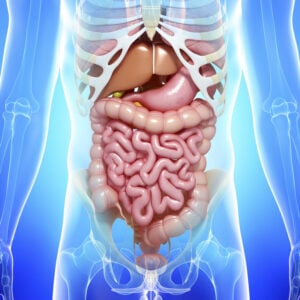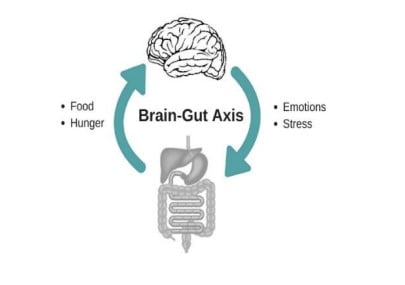Functional gastrointestinal (GI) and motility disorders are the most common GI disorders in the general population. Estimates vary, but about 1 in 4 people or more in the U.S. have one of these disorders.[1,2] The conditions account for about 40% of GI problems seen by doctors and therapists.[2]

Functional GI disorders are disorders of gut–brain interaction. It is a group of disorders classified by GI symptoms related to any combination of the following: motility disturbance, visceral hypersensitivity, altered mucosal and immune function, altered gut microbiota, and altered central nervous system (CNS) processing.[3]
The term “functional” is generally applied to disorders where the body’s normal activities in terms of the movement of the intestines, the sensitivity of the nerves of the intestines, or the way in which the brain controls some of these functions is impaired. However, there are no structural abnormalities that can be seen by endoscopy, x-ray, or blood tests. Thus it is identified by the characteristics of the symptoms and infrequently, when needed, limited tests.

The Rome diagnostic criteria categorize the functional gastrointestinal disorders – disorders of gut-brain interaction – and define symptom based diagnostic criteria for each category.[3]
Esophageal disorders
- Globus – a sensation of a lump, something stuck, or a tightness in the throat
- Functional chest pain – the feeling of chest pain, presumably of esophageal origin (can be confused with cardiac pain which must be examined)
- Functional heartburn – persistent burning sensation in the absence of gastroesophageal reflux disease (GERD), a motility disorder, or a structural explanation
- Functional dysphagia – the sensation of difficulty swallowing
- Reflux hypersensitivity
Gastroduodenal disorders (symptoms generally attributable to the mid or upper gastrointestinal tract)
- Functional dyspepsia – pain or discomfort located in the upper abdomen
- Belching disorders
- Nausea and vomiting disorders
- Rumination syndrome – effortless regurgitation of recently swallowed food
Bowel disorders and abdominal pain (symptoms generally attributable to the mid or lower gastrointestinal tract)
- Irritable bowel syndrome (IBS) – a group of bowel disorders characterized by abdominal discomfort or pain associated with defecation or a change in bowel habit.
- Functional abdominal bloating/distension – a group of functional bowel disorders dominated by a feeling of abdominal fullness or bloating.
- Functional constipation – a group of functional disorders characterized by persistent difficult, infrequent, or seemingly incomplete defecation.
- Functional diarrhea – continuous or recurrent passage of loose or watery stools without abdominal pain.
- Unspecified functional bowel disorder
- Opioid-induced constipation
Centrally mediated disorders of gastrointestinal pain
- Centrally mediated abdominal pain syndrome (CAPS) – continuous or frequently recurrent abdominal pain, either not or infrequently related to gut function, and associated with some loss of daily activities.
- Opioid-induced GI hyperalgesia – characterized by the paradoxical development of, or increases in, abdominal pain associated with continuous or increasing dosages of opioids.
Gallbladder and Sphincter of Oddi (SO) disorders
- Functional pancreatic SO disorder – Sphincter of Oddi dysfunction (SOD) describes the situation when the sphincter does not relax at the appropriate time (due to scarring or spasm). The back-up of juices causes episodes of severe abdominal pain.
- Biliary pain
Anorectal disorders
- Fecal incontinence – recurrent uncontrolled passage of fecal material where no structural or neurological cause is evident.
- Functional anorectal pain– Levator ani syndrome is a dull ache in the rectum that lasts for hours to days. Proctalgia fugax is an infrequent sudden, severe pain in the anal area of short duration.
- Functional defecation disorders – Dyssynergic defecation or inadequate defecatory propulsion.
Childhood functional GI disorders: neonate and toddlers
- Infant regurgitation – uncomplicated involuntary return (regurgitation) of stomach contents into the mouth. Common and normal in infants.
- Infant rumination syndrome – voluntary, habitual regurgitation of recently swallowed stomach contents. Rare.
- Cyclic vomiting syndrome – recurrent episodes of intense nausea and vomiting lasting hours to days separated by symptom-free intervals lasting weeks to months.
- Infant colic – long bouts of crying or irritability without obvious cause.
- Functional diarrhea – daily, painless, recurrent passage of 3 or more large, unformed stools for at least 4 weeks in infancy or preschool years.
- Infant dyschezia – straining and crying with stool passage.
- Functional constipation – infrequent, painful, hard, or large diameter bowel movements.
Childhood functional disorders: children and adolescents
- Functional nausea and vomiting disorders
- Functional abdominal pain disorders – functional dyspepsia, irritable bowel syndrome (IBS), abdominal migraine, childhood functional abdominal pain
- Functional defecation disorders – functional constipation, non-retentive fecal incontinence
References
- Talley NJ. Functional gastrointestinal disorders as a public health problem. Neurogastroenterol Motil. 2008 May;20 Suppl 1:121-129.
- Parkman HP, Doma S. Importance of gastrointestinal motility disorders. Practical Gastroenterology. September 2006.
- Drossman DA, et al. Rome IV, the functional gastrointestinal disorders. Gastroenterology 2016;150:1262–1279.
- Drossman DA, et al. Rome III, the functional gastrointestinal disorders. Gastroenterology. April 2006 Volume 130 Number 5.
